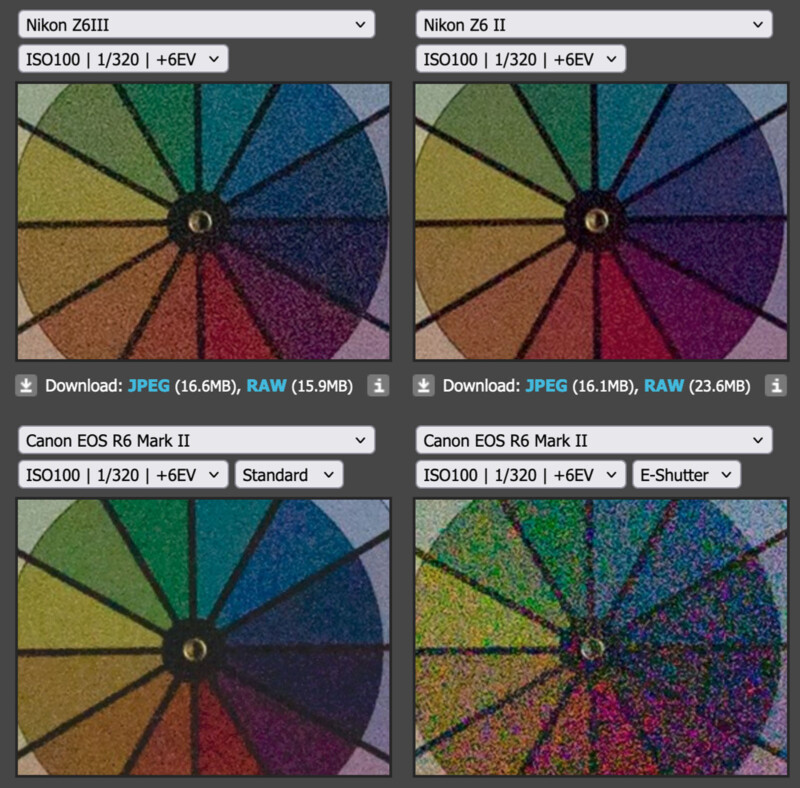![]()
The Nikon Z6 III is a fascinating camera with many compelling features. While the camera’s dynamic range doesn’t match its predecessor’s, detailed lab testing shows that there is some positive news when it comes to overall image quality.
DPReview has just added the Nikon Z6 III to its detailed studio test scene, showing how the Z6 III fares at various ISOs against the competition. As PetaPixel explained in earlier discussions about the Z6 III’s dynamic range, the worse dynamic range matters most when the camera is pushed to extreme scenarios and seldom impacts real-world photography, and certainly not enough to outright dismiss the Z6 III as a competent camera.
DPR‘s testing includes some of these unlikely scenarios, showing what happens the camera is pushed to plus-six EV at base ISO. In this scenario, the Z6 III performs worse than the Z6 II, all else equal, which belies a difference in sensor read noise that itself relates to the gap in peak dynamic range performance. This isn’t surprising, although it is still good to see hard data with downloadable test images.

What perhaps is surprising is that although the Z6 III’s dynamic range and noise performance aren’t as good as the Z6 II’s, the Z6 III holds up very well against the competition, including the Canon EOS R6 Mark II and the Sony a7 IV, especially when the R6 II is used with its electronic shutter, which wreaks havoc on image quality when the files are pushed to extremes.

This result lines up with the dynamic range testing data at Photons to Photos, which shows that the R6 II using its electronic shutter is nearly two stops worse in terms of dynamic range than the camera’s mechanical shutter. Two stops is a lot, by the way — it’s about same dynamic range hit the Z6 III experiences at ISO 1,200 compared to the base ISO of 100.
In PetaPixel‘s testing, the Nikon Z6 III’s dynamic range suffers no discernible hit when using the camera’s electronic shutter. This is notable in multiple ways, including primarily that users can take full advantage of the Z6 III’s class-leading performance without worrying about an image quality penalty. The same cannot be said about the Canon R6 II, of course, and the a7 IV can’t reach the same speeds as the Z6 III in the first place — 10 frames per second (mechanical or electronic shutter) versus 20 for the Z6 III (electronic shutter).
As for sensor readout speed, the Z6 III’s is around 1/60s, as is the R6 II’s, but the Sony a7 IV is much slower — at about 1/15s. In the case of the a7 IV, speed doesn’t improve with the use of the electronic shutter, so it’s not as important of a consideration. However, when it comes to the Z6 III and R6 II, using the electronic shutter matters, and in the case of the R6 II, using the electronic shutter comes at a dramatic cost to image quality.
Another consideration is that while the R6 II can shoot faster than the Z6 III — 40 versus 20 frames per second — its buffer depth is limited to just 75 frames, while the Z6 III can churn and burn for over 1,000 frames, provided the photographer uses a CFexpress Type B card.
This ties back to the Nikon Z6 III situation, as sensor readout speed and electronic shutter performance are part of the context through which image quality and dynamic range must be understood. While the Z6 III’s dynamic range is worse in general, and image quality can be impacted as a result in limited situations, it is, for many photographers, a worthwhile tradeoff for the camera’s increased speed and overall performance.
The Z6 III’s new partially stacked image sensor comes with a dynamic range hit, but it offers more speed and performance than the competition in the sub-$2,500 price bracket, and when an admittedly great camera like the R6 II tries to keep pace by using its electronic shutter (required for the fastest shooting modes), the dynamic range suffers so much more than the Z6 III’s does. As for the Sony a7 IV, its dynamic range is similar to the Z6 II’s, but the camera tops out at 10 frames per second, half the top speed of the Z6 III. They’re in a different league in that respect.
Nikon has not improved peak image quality with its new Z6 III, that much is clear, but the company has achieved a new benchmark in image quality when using the electronic shutter in a very competitive price bracket, and did so while upping the bar in overall features and performance, too.
PetaPixel‘s comprehensive Z6 III review will arrive next week, complete with a deep dive into real-world image quality, autofocus performance, shooting speed, and video performance. There will be plenty more to say about the Z6 III soon, but for now, it’s clear Nikon has achieved an unprecedented blend of speed and image quality compared to its peers.
Image credits: Featured image created using a photo from Nikon and an asset licensed via Depositphotos. Test image courtesy of DPReview.
